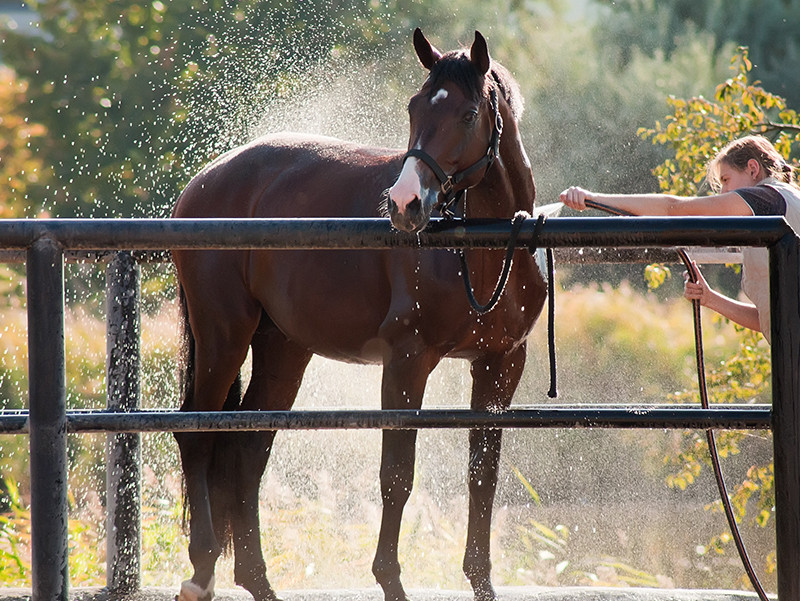With August getting started, also means the hottest month of the year in most parts of the country. It is important to be mindful of our horse’s health on hot days. If you are uncomfortable outside, chances are your horse is too. Take extra precautions for your equine partner to help keep them happy and healthy during the heat of summer.
1. Provide fresh, cool water. Make sure your horse has plenty of fresh, cool water at all times. When stalling at an event, always dump out leftover water and fill with fresh water a few times a day. Also consider hanging two buckets of water to help eliminate the chances of your horse running out. If your horse is picky, try using a water filtration attachment or bring water from home. According to the University of Minnesota, an adult horse weighing 1,000 pounds requires a minimum of 10 to 12 gallons of water each day.
Signs of Dehydration:
- Pinch Test: Pinch skin on a horse’s neck/shoulder, take note of how quickly it springs back. If dehydration is present, skin will stay elevated for a few seconds.
- Eyes and Gums: Check for wrinkled eyelids along with dull/glazed eyes. Look for dark red gums and mucous membranes of the nose and mouth.
- Behavior: Check for sluggish, lethargic, or depressed behavior. Also check for shallow panting and/or body temperature exceeding 102 degrees.
2. Electrolyte source. Consider providing electrolytes to horses that have been sweating heavily or you expect to do so. A balanced electrolyte supplement is designed to replace what is lost from perspiration and encourage water consumption. MVP offers two electrolyte products: Electro-Cell and Apple-Lyte, an apple-flavored powder. Water laced with electrolytes can help keep its body in balance. However, whenever you offer electrolytes such as Apple-Lyte mixed in water, be sure to offer a second source of fresh water, as well. Not all horses will drink electrolyte-laced water, so providing a source of water without them will ensure your horse keeps drinking.
3. Reduce workload. Watch temperatures and humidity levels. Even when your horse is in great shape, when temperatures reach 90°F be mindful of your horse’s well-being. Humidity can also affect the quality of air your horse is breathing. Consider riding in the early morning or late evening to avoid riding during peak temperatures on those especially hot days. If you’re at an event, lighten the workload or reduce your warmup time. And always be sure to allow your horse to cool down slowly and take tack off as soon as possible.
4. Move the air. Fans are a great way to help keep the air moving if your horse is stalling at an event. Always ensure that your horse can’t get a hold of cords and plugs and try to hang the stall in a place where your horse can comfortably stand in their stall.
5. Shade is your friend. Whether you’re at a day event or stalling somewhere for the weekend, remember to provide relief from the sun. Also be aware that sometimes it can be cooler outside at your horse trailer than in a stall barn. If you’re able to tie to the trailer at events, this is a great option to help your horse stay cool with natural air flow and shade.
6. Hose off your horse. Whether you just completed riding or your horse is having a day off, hosing your horse off with water can help keep him cool and relaxed on hot days. Hose him with cool, running water, or sponge with liberal amounts of water over his entire body until the water running off is no longer hot. Make sure to scrape off excess water.
7. Promptly remove leg wraps. Leg protection is crucial in some disciplines to keep your equine partner safe in the competition pen. Luckily many sport boots are made with light and breathable material. However, after your run find a safe place to promptly remove your sport medicine boots or wraps to alleviate your horse’s legs from heat.
8. Know the signs heat stroke. Heat stress can easily lead to heat stroke. It can happen anytime your horse is exposed to excessive heat that his body cannot handle. It may occur when horses are worked hard in extreme heat and/or humidity but be aware that it can also happen if standing in a hot stall or trailer.
Have an idea of your horse’s normal temperature, heart, and respiratory rates. To find the heart rate of a horse, simply find a pulse and count the beats for 15 seconds, then multiply that number by four, which will give the beats per minute. Count the breaths per minute in a similar way.
According to the University of Minnesota, signs of heat stress/stroke can include:
- Rectal temperatures above 103 F
- Increased heart rate
- Increased breathing rate
- Profuse sweating
- Droopy ears
- Tiredness
- Dehydration
- Skin tent lasting several seconds after pinching the skin of the neck or shoulders
- Reduced feed intake


